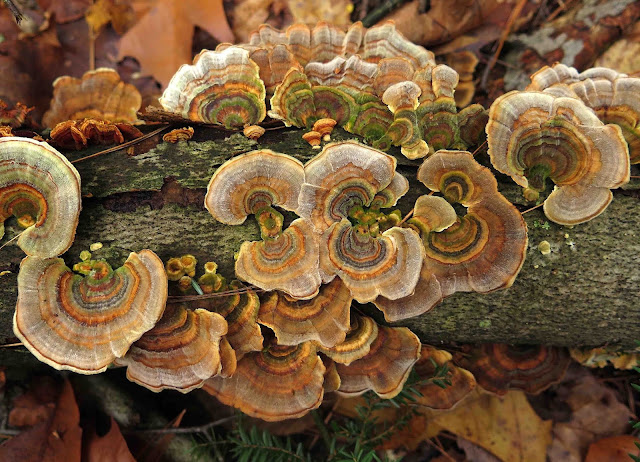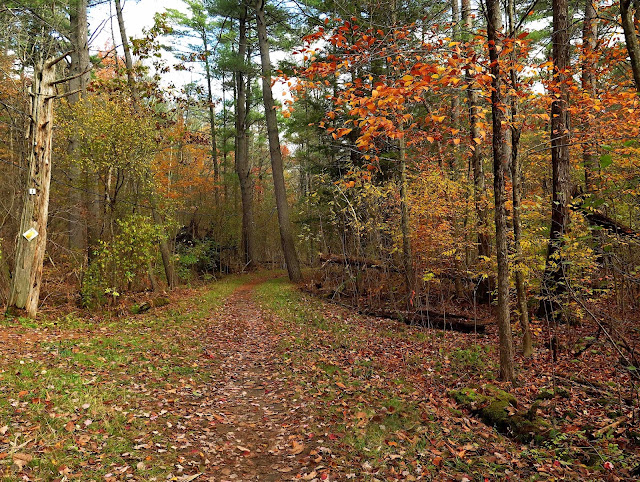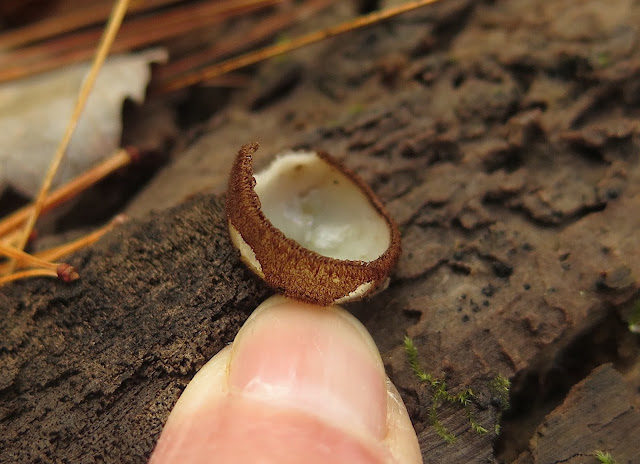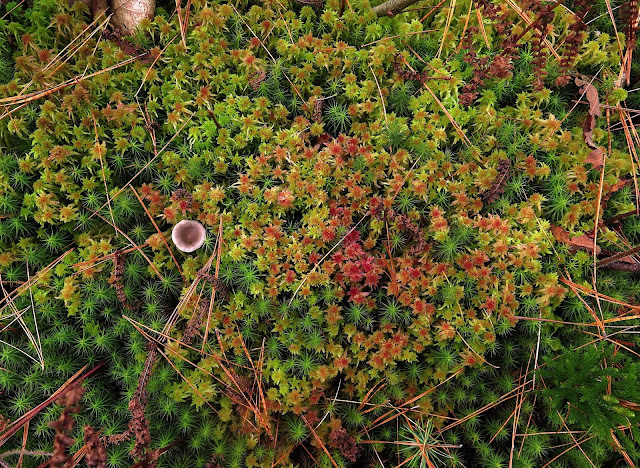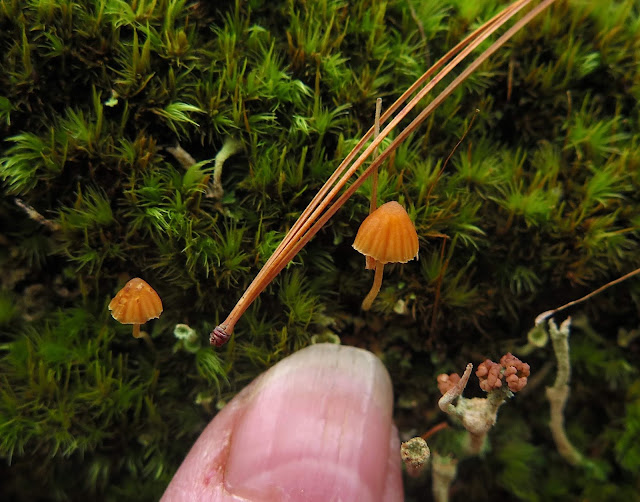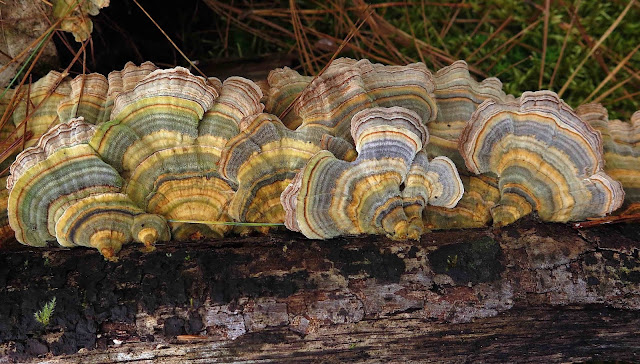The summer flowers have faded, and the brilliant autumn foliage will soon be fading, too. So what's left to entice a nature lover outdoors? Why, mosses and mushrooms, of course! And since our own great personal resource for mosses, our friend Ruth Brooks, will soon be leaving us for her winter home in Florida, my friend Sue and I just HAD to go mossing with her this past week -- especially since Ruth had found a rarely reported aquatic moss called Fissidens fontana just a few days before and wanted us to go back with her to revisit the place she had found it. So we met on the shore of the Hudson River last Wednesday morning, ready to paddle with her to the riverside cove where this moss could be found.

It wasn't the nicest day for a paddle, with rain expected momentarily and fine droplets already misting the air. But that never stopped us before from setting out in our solo canoes, especially if an exciting find lay in the prospect. But what we discovered when we met at the launch site DID stop us: the water level in the river had been lowered for dam repairs downstream. Yes, we could have entered the river and paddled mid-stream, but we sure could not paddle close enough to the banks to examine what mosses grew there. Time for Plan B.
"No problem," I told my friends. "We can walk to the site." I knew that because I had walked there many times before, over the years, making my way through the woods and along the riverbank to a small cove where a stream joined the river. It was in that cove that Ruth had found her remarkable moss. So off we went.
When we reached the cove and discovered it mostly emptied of water, that gave Ruth a momentary pause. Last week, she had found this aquatic moss submerged and floating just beneath the water's surface. Would she be able to recognize it when stranded on the rocky bottom?
Well, yes, she certainly did! Tangled masses of the dark-colored moss called Limp Pocket Moss (Fissidens fontana) lived up to its common name by lying limply across this large wet rock.


Here's what Limp Pocket Moss looks like when floating free in the water. One would need a magnifier to notice how the lower corner of each small narrow leaf is folded over to form a small pocket, the reason this moss is designated a "pocket moss." I believe even Ruth did not notice this pocket when she first saw this moss, simply recognizing it as one she had never seen before, and it looked very interesting. After collecting a sample, which she later examined with her microscope at home, and then conferring with a bryologist, Ruth was excited to learn that this moss has never yet been reported this far north in New York State. This moss may not be that uncommon, though. More likely it is just rarely seen, growing underwater as it does. I would say this just goes to prove what a remarkable "mosser" our friend Ruth Brooks is.

And here's more evidence of Ruth's ability to spot the unusual find. Not 10 feet away from where she found the Limp Pocket Moss, she spotted another similarly colored aquatic moss that normally flourishes underwater. How she recognized this dark tangled mass as a different moss than the one we had come here to find, is beyond me. But Ruth immediately put the name Fontanalis antipyretica to this one. Keeled Water Moss is its vernacular name, suggested by its deeply keeled, spearhead-shaped leaves. That feature is not evident in my photos of this moss, but Ruth assured us that she could observe that keel with her magnifier loupe. She also told us that the "antipyretic" part of this moss's name refers to its medicinal use as a treatment for high fever.
I wonder what this Green Frog felt when he heard us whooping it up about our moss finds? He kept very still in the hope of remaining unseen when we stooped to look at him.

Of course, we had found many other mosses on our walk through the woods to the cove. Here, Ruth and Sue stoop to examine some that are covering this rotting log.
We found no rare ones under the trees, but the common mosses, such as this beautiful mound of Brocade Moss (Hypnum imponens), looked especially green and vibrant, thanks to much rain this year.
When this moss, called Atrichum undulatum, is dry or really cold, the rumpled leaves curl up in a squiggly mass. It was obvious that these open leaves were receiving plenty of water on this rather warm rainy day.
And oh boy, did we find FUNGI in this woods! Many of them we could not name, but I did recognize this enormous clump as Honey Mushroom (Armillaria mellea), grown to such a size it might barely fit in a bushel basket.
From huge to tiny! This pretty little cluster of small tan mushrooms had found their niche in the knothole of a fallen twig.
My photo really does not do justice to how remarkably pink these Russulas (species unknown) appeared on the forest floor. The stems and gills were snowy white, but their caps almost looked as if they had been bleeding.
I hardly ever find a bright-red Russula emetica that hasn't had its cap partly devoured by some woodland creature, probably snails or slugs. So I was delighted to find this one so beautifully intact.
This lovely yellow coral mushroom looked so unique I was sure I would quickly find it described in one of my five mushroom guides. But no, after thumbing through all of them, I found nothing that looked quite like this. Suggestions would gladly be welcomed.
These lovely pale-yellow discs reminded me of butter cookies. Again, species unknown.
And how appropriate to find very near to those butter-cookie-like caps this dark-brown, white-gilled mushroom with the common name Chocolate Milky (Lactarius lignyotus). Like all Lactarius species, this one does seep a milky fluid when its gills are cut, but my mushroom guides discourage consuming members of this genus, since they are easily confused with one another and not all are edible.
These tight little scaly-topped buttons, possibly Pholiota squarrosa, also resembled something tempting, like coconut macaroons, but I would never eat them. I have difficulty distinguishing Pholiota species, especially when immature, like these. But I could still feast my eyes on them, they were so cute!
When we encountered this giant tiered bracket fungus, we were impressed, first, by its size, and then by the way it seemed to be dribbling water from every edge.
Sue suggested I try using my camera's flash to better illuminate those droplets. So I did. And WHOA! Just look at how this fungus sparkles! As if it were adorned with tiny Christmas lights.
That drippiness suggested to me that this might be the Resinous Polypore (Ischnoderma resinosum), which one of my mushroom guides describes as forming droplets of liquid on the cap margin and pore surface. The ruddy brown color of the top surface, as well as the soft and flexible caps, which I could bend down to inspect, were further details that convinced me that my guess was correct.
Here's what this fascinating fungus looks like straight on. Just one more intriguing find on this mid-October day, when some might think there was little left of interest in the woods or on the water.














